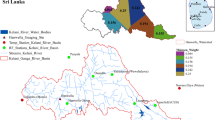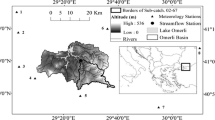Abstract
Investigation of the relationship between catchment hydrology with climate is essential for understanding of the impact of future climate on hydrological extremes, which may cause frequent flooding, drought, and shortage of water supply. The purpose of this study is to investigate the effects of climate change on extreme flows in one of the subcatchments of the Ilam dam catchment, Iran. The changes in climate parameters were predicted using the outputs of HadCM3 model for up to the end of the current century in three time periods including 2020s, 2050s, and 2080s. For A2 scenario, increases of 1.09°C, 2.03°C, and 3.62°C, and for B2 scenario rises of 1.18°C, 1.84°C, and 2.55°C have been predicted. The results suggest that for A2 scenario, the amount of precipitation would decrease by 12.63, 49.13, and 63.42 and for B2 scenario by 47.02, 48.51, and 70.26 mm per year. Also the values of PET for A2 scenario would increase by 51.18, 101.47 and 108.71 and for B2 scenario by 60.09, 89.86, and 124.32 mm per year. The results of running the SWAT model revealed that the average annual runoff would decrease by 0.11, 0.41, and 0.61 m3/s and for B2 scenario by 0.39, 0.47, and 0.59 3/s. The extreme flows were then analyzed by running WETSPRO model. According to the results, the amounts of low flows for A2 scenario will decrease by 0.02, 0.21 and 0.33 3/s and for B2 scenario by 0.19, 0.26 and 0.29 3/s in the 2020s, 2050s and 2080s, respectively. On the other hand, the results show an increase of peak flows by 11.5, 19.1 and 48.7 3/s in A2 scenario and 11.12, 25.93 and 48.1 3/s in B2 scenario, respectively. Overall, the results indicated that an increase in return period leads to elevated levels of high flows and diminished low flows.
Similar content being viewed by others
References
Ahiablame L, Sinha T, Paul M, Ji J H, Rajib A (2017). Streamflow response to potential land use and climate changes in the James River watershed, Upper Midwest United States. J Hydrol Reg Stud, 14: 150–166
Artlert K, Chaleeraktrakoon C, Nguyen V V (2013). Modeling and analysis of rainfall processes in the context of climate change for Mekong, Chi, and Mun River Basins, Thailand. J Hydro-environment Res, 7(1): 2–17
Ashofteh P, Massahbouani A R (2010). Impact of climate change on maximum discharges: case study of Aidoghmoush Basin, East Azerbaijan. J Water Soil Sci, 14(53): 28–38 (in Persian)
Azari M, Moradi HR, Saghafian M, Faramarzi M (2013). Assessment of hydrological effects of climate change in Gourganroud River Catchment. J Water Soil Sci 27 (3): 537–547 (in Persian)
Bae D H, Jung IW, Lettenmaier D P (2011). Hydrologic uncertainties in climate change from IPCC AR4 GCM simulations of the Chungju Basin, Korea. J Hydrol (Amst), 401(1–2): 90–105
Baguis P, Roulin E, Willems P, Ntegeka V (2010). Climate change and hydrological extremes in Belgian catchments. Hydrol Earth Syst Sci, 7(4): 5033–5078
Basher M A, Liu T, Kabir M A, Ntegeka V, Willems P (2010). Climate change impact on the hydrological extremes in the Kaidu River Catchment, China. J Food Eng, 1(2): 93–108
Bitew M, Gebremichael M, Ghebremichael L T, Bayissa Y A (2012). Evaluation of high-resolution satellite rainfall products through streamflow simulation in a hydrological modeling of a small mountainous catchment in Ethiopia. J Hydrometeorol, 13(1): 338–350
Bodian A, Dezetter A, Diop L, Deme A, Djaman K, Diop A (2018). Future climate change impacts on streamflows of two main West Africa river basins: Senegal and Gambia. J Hydrol, 5(21)
Collet L, Beevers L, Prudhomme Ch (2017). Assessing the impact of climate change and extreme value uncertainty to extreme flows across Great Britain. Water, 9(2): 103
Devkota L P, Gyawali D R (2015). Impacts of climate change on hydrological regime and water resources management of the Koshi River Basin, Nepal. J Hydrol Reg Stud, 4: 502–515
Garner G, Van Loon A, Prudhomme C, Hannah D (2015). Hydroclimatology of extreme river flows. Freshw Biol, 60(12): 2461–2476
Gholami Sh, Nasiri M (2015). Simulation of Atrack River monthly discharge using SWAT model, case study: Maraveh Tappeh Catchment, Gholestan Province. J Water Eng Ma 7 (2) 126–135 (in Persian)
Hansen J, Sato M, Kharecha P, Beerling D, Berner R, Masson-Delmotte V, Zachos J C (2008). Target atmospheric CO2: Where should humanity aim? J Atmos Sci, 2(1): 217–231 aiia]IPCC (2007). Climate change 2007: The physical science basis. Contribution of working group I to the fourth assessment report of the Intergovernmental Panel on Climate Change, S. Solomon, et al., eds., Cambridge University Press, Cambridge, UK
Jiang T, Chen Y D, Xu C Y, Chen X, Chen X, Singh V P (2007). Comparison of hydrological impacts of climate change simulated by six hydrological models in the Dongjiang Basin, South China. J Hydrol, 336(3–4): 316–333
Kavian A, Namdar M, Gholshan M, Bahri M (2017). Hydrological modeling of climate changes impacts on flow discharge in Haraz River Catchment. JNat Env Hazard, 6(12): 89–104 (in Persian)
Kavvas M L, Chen Z Q, Ohara N, Bin Shaaban A J, Amin M Z M (2006). Impact of climate change on the hydrology and water resources of Peninsular Malaysia. International Congress on River Basin Management, 529–537
Kazmi D H, Rasul G, Li J, Cheema S B(2014). Comparative study for ECHAM5 and SDSM in Downscaling Temperature for a Geo-Climatically Diversified Region, Pakistan. J Appl Math, 5: 137–143
Leta O T, El-Kadi A I, Dulai H (2018). Impact of climate change on daily streamflow and its extreme values in Pacific island watersheds. Sustainability, 10(6): 2057–2079
Leta O T, El-Kadi A I, Dulai H, Ghazal K A (2016). Assessment of climate change impacts on water balance components of Heeia watershed in Hawaii. J Hydrol Reg Stud, 8: 182–197
Mohammed K, Saiful Islam A K, Tarekul Islam G M, Alfieri L, Bala S K, Uddin Khan M J(2017). Impact of high-end climate change on floods and low flows of the Brahmaputra river. J Hydrol Eng, 22(10): 04017041
Moradi HR, Taei Semiomi S, Khodagholi M (2014). Simulation and prediction some of climate variable by using multi line SDSM and Global Circulation Models (case study: Bar Catchment Nayshabour). Hum Env, 28? (in Persian)
Poelmans L, Rompaey A V, Ntegeka V, Willems P (2011). The relative impact of climate change and urban expansion on peak flows: a case study in central Belgium. Hydol Process, 25(18): 2846–2858
Rahman K, Etienne C, Gago-Silva A, Maringanti C, Beniston M, Lehmann A (2014). Streamflow response to regional climate model output in the mountainous watershed: a case study from the Swiss Alps. Environ Earth Sci, 72(11): 4357–4369
Tank A K, Zwiers F W, Zhang X (2009). Guidelines on Analysis of extremes in a changing climate in support of informed decisions for adaptation. World Meteorological Organization
Tatsumi K, Oizumi T, Yamashiki Y (2013). Introduction of daily minimum and maximum temperature change signal in the Shikoku region using the statistical downscaling method by GCMs. Hydrol Res Let, 7(3): 48–53
Tavakoli M, De Smedt F (2012). Impact of climate change on stream flow and soil moisture in the Vermilion catchment, Illinois, USA. J Hydrol Eng, 17(10): 1059–1070
Tavakoli M, De Smedt F, Vansteenkiste Th, Willems P (2014). Impact of climate change and urban development on extreme flows in the Grote Nete watershed, Belgium. Nat Hazard J, 71(3): 2127–2142
Wilby R L, Dawson C W, Barrow E M (2002). SDSM—a decision support tool for the assessment of regional climate change impact. Environ Model Softw, 17(2): 145–157
Willems P (2004). Water Engineering Time Series Processing tool WETSPRO version 2.0, Reference Manual. Hydraulics Laboratory, K.U. Leuven, Belgium
Willems P (2009). A time series tool to support the multi-criteria performance evaluation of rainfall-runoff models. Environ Model Softw, 24(3): 311–321
WMO (2011). Statements of the Status of Global Climate. Geneva, Switzerland
Yan Z, Jones P D, Davies T D, Moberg A, Bergström H, Camuffo D, Cocheo C, Maugeri M, Demarée G R, Verhoeve T, Thoen E, Barriendos M, Rodríguez R, Martín-Vide J, Yang C (2002). Trends of Extreme Temperatures in Europe and China Based on Daily Observations. Clim Change, 53(–3): 355–392
Zarghami M, Abdi A, Babaeian I, Hassanzadeh Y, Kanani R (2011). Impact of climate change on runoffs in East Azarbaijan, Iran. Glob Planet Change, 78(3–4): 137–146
Author information
Authors and Affiliations
Corresponding author
Rights and permissions
About this article
Cite this article
Safaryan, S., Tavakoli, M., Rostami, N. et al. Evaluation of climate change effects on extreme flows in a catchment of western Iran. Front. Earth Sci. 13, 523–534 (2019). https://doi.org/10.1007/s11707-019-0761-0
Received:
Accepted:
Published:
Issue Date:
DOI: https://doi.org/10.1007/s11707-019-0761-0




